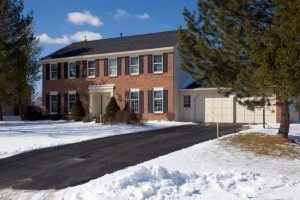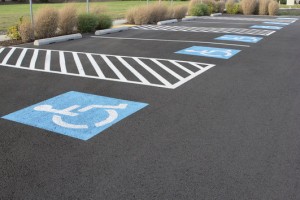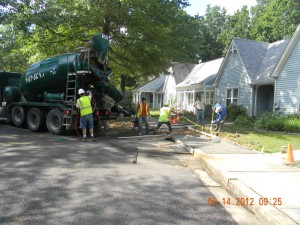Maryland’s autumn season brings cold weather along with snow, ice, and other seasonal hazards, and it can be difficult to maintain your driveway during the colder months. But driveway maintenance is important if you want to protect the cement or asphalt and maintain your home’s attractive curb appeal. And of course, driveway’s can be a safety issue during fall and it’s important to avoid the risks of slipping on ice or snow, both inside or outside the car.
Blog
Your Autumn Driveway Checklist
September 1st, 2017The Many Benefits of Sealcoating
August 25th, 2017Sealcoating a thin liquid layer added over a paved surface serves to protect it from damage caused by UV rays, rain and snow, and fluids from vehicles. Sealcoating won’t cure existing issues, like cracks, but it will help prevent such damage from forming in the first place. Aside from keeping out damaging elements, properly applying a sealcoat is important to extend the life of asphalt paving. Sealcoating protects and prolongs the life expectancy of asphalt pavement by filling surface damage and providing a protective layer to keep out damaging UV rays, vehicle fluids and water. Read the rest of this entry »
What Is Asphalt Seal Coating?
August 4th, 2017Seal coating is a true barrier between asphalt surfaces and the destructive elements. The term “seal coating” means keeping the redeeming properties of asphalt sealed in to prolong the pavement life and preserve its functional properties. The primary reason to sealcoat an asphalt pavement is to protect the pavement from the deteriorating effects of sun and water. When asphalt pavement is exposed to sun, wind and water, the asphalt hardens, or oxidizes. This causes the pavement to become more brittle. As a result, the pavement will crack because it is unable to bend and flex when exposed to traffic and temperature changes. Read the rest of this entry »
How to Remove Sidewalk Trip Hazards
July 28th, 2017Trip hazards are not uncommon on sidewalks or patios where concrete may have broken, chipped, or shifted from frosts, tree roots or just natural formation. There are basically two kinds of concrete: concrete that cracks and concrete that is going to crack. Federal law requires the removal of all trip hazards from all pedestrian walkways. Because the ADA demands compliance, trip hazards present a legal liability. By eliminating trip hazards, property owners reduce their legal liability. Read the rest of this entry »
What’s the Difference Between Cement and Concrete?
July 25th, 2017Most people don’t know the difference between cement and concrete. While cement and concrete do stem from the same family, they are nowhere near the same thing. Cement is a fine grey powder which looks very much like grey flour. Most people wouldn’t encounter cement in their everyday lives. Concrete is the actual mixture of cement, sand, rock, water, and small amounts of additives. Concrete is the material we encounter in our everyday lives, such as roads, sidewalks, and parking lots.
Read the rest of this entry »
How to Mill and Pave a New Parking Lot
July 18th, 2017Pavement milling, or cold planning, asphalt milling, or profiling, is the process of removing at least part of the surface of a paved area such as a road, bridge, or parking lot. Milling removes anywhere from just enough thickness to level and smooth the surface to a full depth removal. There are many different reasons for milling a paved area instead of simply repaving over the existing surface. Recycling of the surface is one of the main reasons for milling a road surface. Milling is widely used for pavement recycling today, where the pavement is removed and ground up to be used as the aggregate in new surface.
Read the rest of this entry »
What is a French Drain and When is it Needed?
July 9th, 2017A French drain is a trench filled with gravel or rock or containing a perforated pipe that redirects surface water and groundwater away from an area. A French drain can have perforated hollow pipes along the bottom to quickly vent water that seeps down through the upper gravel or rock. French drains are primarily used to prevent ground and surface water from penetrating or damaging building foundations. Alternatively, French drains may be used to distribute water, such as a septic drain field at the outlet of a typical septic tank sewage treatment system. French drains are also used behind retaining walls to relieve ground water pressure. Read the rest of this entry »
How Is Concrete Properly Installed?
June 30th, 2017The proper installation methods make a huge difference with every construction project, and installing concrete is no different. What does proper concrete installation look like and how can you ensure that you use a contractor that follows the best practices? Read on! Read the rest of this entry »
When Do You Need a Retaining Wall?
June 22nd, 2017Think about the places you’ve been? Do you remember seeing a retaining wall?
Chances are you have seen many, you just may not remember. Retaining walls are
everywhere: Schools, homes, and businesses all use them. A properly built retaining
wall is a functional and beautiful addition to any property that might need one. Here
is a little more information about retaining walls you may find helpful. Read the rest of this entry »
Concrete vs. Asphalt
June 16th, 2017
Before selecting the materials of your driveway, it is important to know the differences between concrete and asphalt.
Concrete and asphalt are both great materials for parking lots, driveways, and more. If you are
interested in potentially changing the parking lot at your property to concrete or asphalt, here’s
what you need to know. Today we will be discussing the core differences between concrete and
asphalt. Read the rest of this entry »


























